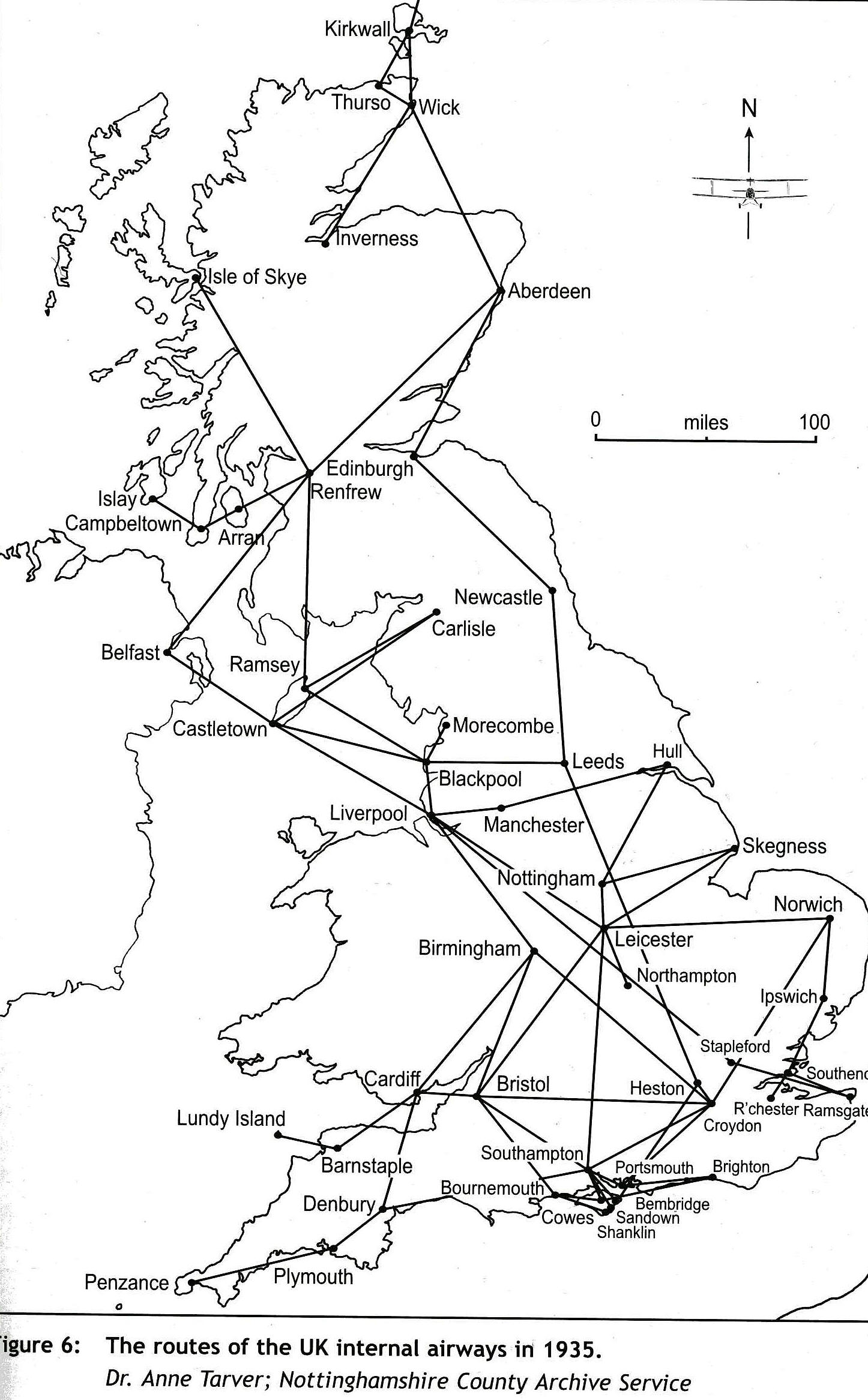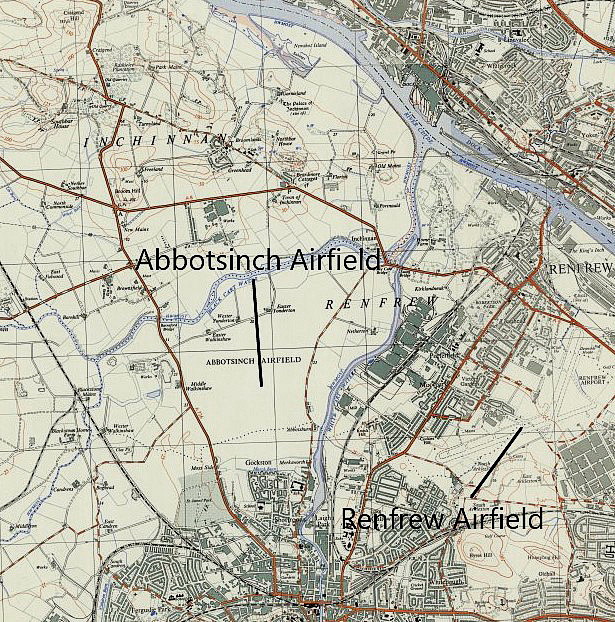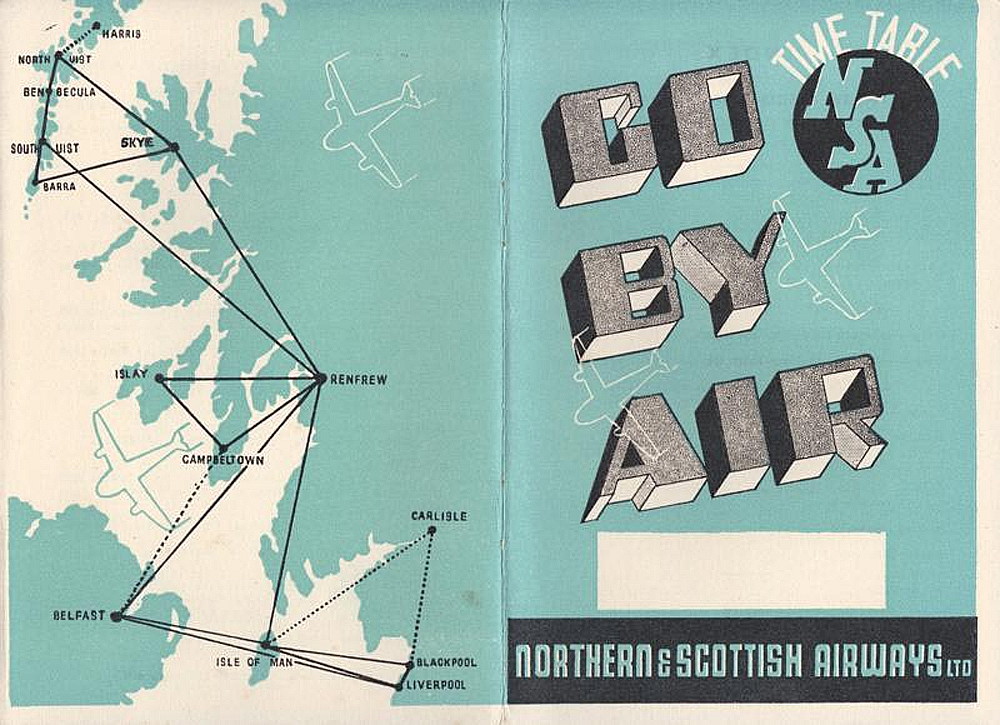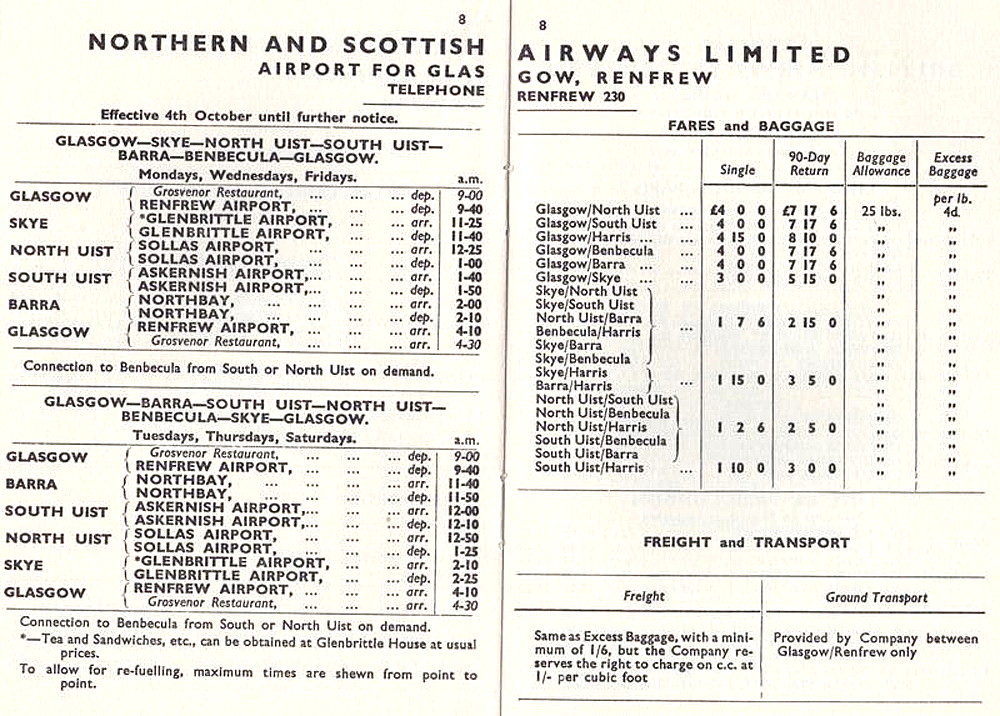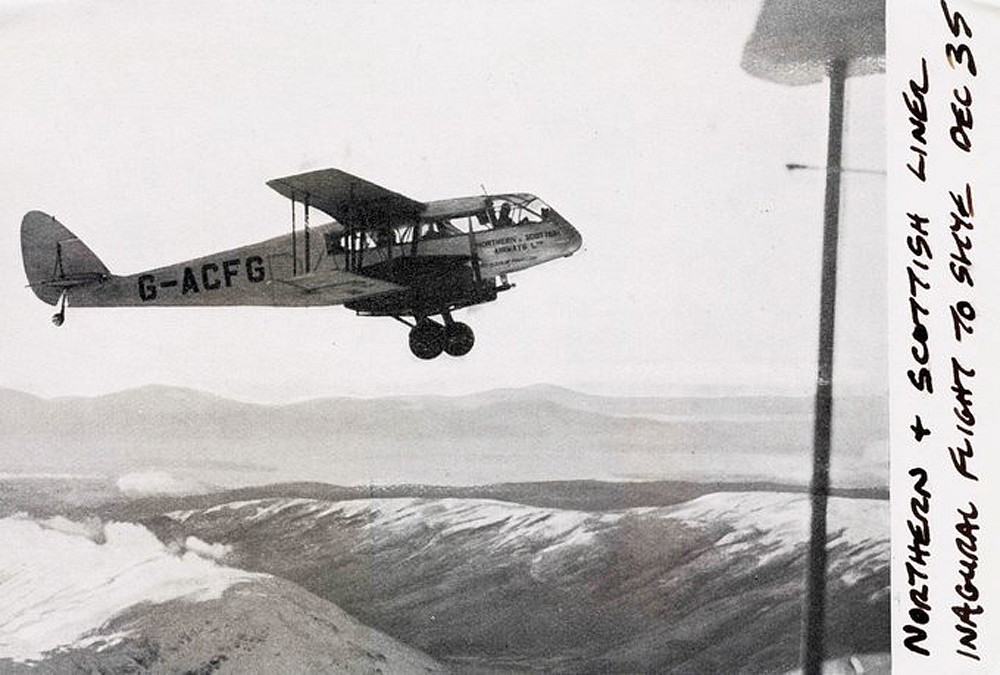Renfrew
Note: This map gives just a general location of the RENFREW airport location. If this can be confirmed I will much appreciate it.
RENFREW AIRPORT
Originally a military WW1 airfield (MOORPARK). Later a civil aerodrome and later still after WW2 especially a major regional Airport
Note: See MOORPARK for details of the earlier period.
Military users: (MOORPARK) WW1+: No.6 Air Acceptance Park
55 Sqdn (What part did they play?)
RFC/RAF Aircraft Repair Depot 1915 to 1920
Between the wars:
Auxillary Air Force “City of Glasgow” 602 Squadron (Airco DH.9s, then Fairey Fawns, Westland Wapitis, Hawker Harts and later Hinds. Later again Hawker Hectors then Gloster Gauntlets before receiving Vickers-Supermarine Spitfires in 1939.
WW2: 309 (Polish) Sqdn (Westland Lysanders)
Post WW2: 602 Sqdn (Vickers-Supermarine Spitfires, DH Vampires)
Operated by: 1965 Ministry of Aviation
Activities: Airline, air freight, charter, GA business and private. Regional airline maintenance
British airline users: Pre 1940: Aberdeen Airways, Aircraft Transport & Travel, Hillman’s Airways, Isle of Man Air Services, London, Scottish & Provincial Airways, Midland & Scottish Air Ferries, North Eastern Airways, Northern & Scottish Airways, Railway Air Services, Scottish Airways, United Airways, Western Isles Airways, William Beardmore & Co Ltd
Post 1945: Autair, BEA, BKS (?), British Island Airways, British United Airways, Cambrian Airways, Derby Airways, Derby Aviation, Dragon Airways, Jersey Airlines, Manx Airlines, Scottish Airways
Foreign airline users: Post 1945: Aer Lingus, Icelandair, Loftleider, Sabena (Surely there must be more?)
Cargo, charter: Post 1945: ACE Scotland, Air Charter (Scotland), Air Condor, Air Enterprises, Air Safaris, British Westpoint, Casair, Capital Services, Dan Air
Flying schools: WW1: Beardmore School 1915 to 1918
Pre 1940: Renfrewshire Flying Services, William Beardmore & Co Reserve Flying School
Flying club: Pre 1940: The Scottish Flying Club
(With superb facilities, possibly the best in the UK)
Post 1945: Capital Services, Scottish Flying Club (1953 to 1956)
Maintenance: Post 1945: BEA Scottish engineering base
Manufacturing: WW1: Fairfield Shipbuilding & Engineering Co, W & J Weir
Pre 1940: William Beardmore & Co Ltd.
WW2: Lockheed Overseas Corporation aircraft assembly plant
Location: 5nm WNW of Glasgow city centre
Period of operation: WW1 military 1914 to 1918, some say 1920. Civil 1933 to 1966 when ABBOTTSINCH re-opened as the main Glasgow airport
Site area: WW1: 120 acres 823 x 594 (MOORPARK)
Notes: The first picture is from The John Stroud Collection. The map is reproduced with the kind permission of Pooleys Flight Equipment. Copyright Robert Pooley 2014.
Runways: WW2 : Some say the 08/26 runway was just over 1800 metres in WW2 and the 03/21 runway was 1220 metres in length
It was during WW2 that this site became a huge maintenance centre for American-built aircraft and they added the two hard runways and several more hangars were erected.
1956: 08/26 1764x46 hard 03/21 1170x46 hard
1965: 08/26 1764x46 hard 03/21 1170x46 hard
A MICHAEL T HOLDER GALLERY
Note: In the first picture the Armstrong-Whitworth Argosy G-EBLF can clearly be seen here. In the second picture, a de Havilland DH83 Fox Moth, operated by Midland and Scottish Air Ferries, is seen about to embark on the first commercial scheduled air service from RENFREW to CAMPELTOWN on the 18th April 1933. The third picture of G-EBLF is from around 1929/30. This Argosy 1 was operated by Imperial Airways from May 1925 until December 1934, and named 'City of Glasgow'.
The fourth picture is of the first ambulance flight conducted by Midland and Scottish Air Ferries on the 14th May 1933. On this occassion bringing a Mr John McDemid from Islay, probably for treatment in the Glasgow Infirmary. Without much doubt his trip in the ambulance was much rougher than the flight!
Since launching this 'Guide' onto the interweb, it has proved to be a rather humbling experience, as so many very kind and generous people kindly offer to help in so many ways. Mike Holder is a splendid example, and the gallery above really does illustrate just how much can be added for our interest and appreciation.
Also highly recommended reading is, A Sense of Place, Glasgow at the Millennium by Dugald Cameron OBE. Published in 2000 by Paisley: BAA Glasgow in association with Squadron Prints,
NOTES: The arrival of regular commercial air services throughout most of Scotland were remarkably quick in being established. Virtually no internal regular commercial services existed even in England until the 1930s. The crucial year was 1933 when Midland & Scottish Air Ferries started operations at RENFREW (then known as MOORPARK) founded by John Sword a bus operator. Also that year Edmund Freeson founded Highland Airways in Inverness. A year later Eric Gander Dower founded Aberdeen Airways. To quote from Air Ambulance by Iain Hutchinson, “Small airfields were built in Kintyre and the Hebrides, and at Inverness, Thurso, Wick, Kirkwall and Sumburgh. Additionally, some primitive strips were cleared elsewhere, in the heather, the bogs and on the beaches, so that aircraft could land in an emergency.” I suppose it is doubtful today that many of these latter sites can now be identified? But I will try to identify as many as possible.
The first flights, (by two DH Fox Moths), by Midland and Scottish Air Ferries were to THE STRATH near Campbeltown on the 18th April 1933. Another detail I find of special interest is that on the 27th April 1933 Winnie Drinkwater flew the DH Fox Moth G-ACBZ on her first scheduled flight. She was apparently the first Scottish woman to obtain a commercial pilots license and she flew fly on regular air services in Scotland.
The first commercial service to Islay appears to have been on the 16th May 1933. The rate of expansion was quite extraordinary – a service to Belfast (ALDERGROVE) being inaugurated on the 30th May 1933. The airline was also operating services from HOOTON (CHESHIRE) and SPEKE (LANCASHIRE) – both known as ‘LIVERPOOL’ to Dublin and the Isle-of-Man, often calling in at Blackpool.
THE AIR AMBULANCE
The work done by Iain Hutchinson has proved invaluable in identifying some of these “primitive” sites and of course they came into their own once the immense humanitarian value of ‘Air Ambulance’ services quickly became appreciated by the normally considered conservative medical profession. He records the very first air ambulance flight as being on the 14th May 1933 when Midland and Scottish Air Ferries “......revolutionised medical practice in Scotland when it flew…(a) patient from ISLAY to RENFREW.”
On the 14th June 1933 the Midland and Scottish Air Ferries pilot Jimmy Orrell set out in the DH Dragon G-ACCZ to survey new landing places for air ambulance duties. This ‘tour’ took him to Barra, Crinan, Coll, Oban, Sollas and Stornoway. It seems bad weather curtailed his plans to also survey St Kilda. The latter being an odd choice today because, according to ‘official’ records the entire population had been evacuated three years earlier. The fact that Captain Orrell intended to visit this remote island seems to clearly indicate he had some reason to believe some people had remained on the island? In such circumstances local knowledge takes some beating.
MIDLAND and SCOTTISH AIR FERRIES
By 1934 Midland and Scottish Air Ferries fleet comprised seventeen aircraft, the biggest independent fleet in pre-war Britain it is claimed. These included:
Airspeed Ferry G-ACBT & G-ACFB
Avro 642/2m G-ACFV
Avro X G-ACGF
De Havilland DH83 Fox Moth G-ACBZ, G-ACCB, G-ACCT & G-ACCU
De Havilland DH84 Dragon G-ACCZ, G-ACDL & G-ACJS
This leaves six more aircraft to identify. I think it feasible that the Fox Moth C-ACEJ may well have been on this fleet, and that aircraft is still flying.
On the 30th May 1933 Midland and Scottish Air Ferries introduced a service from RENFREW, via CAMPBELTOWN to Belfast using their new sixteen passenger Avro 642/2m. I wonder where they landed in/near Belfast in those days? They also had regular services to the Isle of Man and Dublin. It does appear that the success of this airline quickly brought about the end of John Swords ambitions. It is claimed that a combination of envy, politics and commercial interests quickly dealt a fatal blow to his ambitions. This said, it also appears he was going way ‘over-the-top’ in furthering his personal wealth and influence? His airline formed in 1932 was closed in 1934 when the directors of SMT, (of which he was one), voted to get him out.
As a mark of the man, it is told that even when he realised his airline was finished he employed Charles Almond, an instructor with the Scottish Flying Club, to fly the Dragon G-ACJS which was retained on ‘stand-by’ to perform air ambulance flights.
On the other hand I would recommend reading The Triple Alliance by Neville Doyle, whereby he gives a quite different appraisal of the situation. So different that one can only sit back and wonder what the ‘truth’ is? And that of course is the essential problem with history. Personal accounts cannot be relied upon or biographies ‘auto’ or otherwise, nor ‘official’ records either. Without doubt some accounts are very exact, but others a sham – and worthless. The problem being how to determine which is which? For me it seems quite remarkable that John Sword would appoint a ‘chancer’ like George Nicholson (of the failed Northern Airways) to take over his airline in 1935. But he did.
OTHER RENFREW SERVICES
From the 20th August 1934 Railway Air Services commenced a service from CROYDON via Birmingham (CASTLE BROMWICH) – Manchester (BARTON) – Belfast (ALDERGROVE?), using two DH.86s G-ACPL and G-ACVY.
It appears that Aberdeen Airways started a service from DYCE on the 10th September 1934 using the Short Scion G-ACUV.
NORTHERN & SCOTTISH AIRWAYS
Note: These three items have also been kindly provided by Mike Holder. The air-to-air photo was taken during the inaugral flight, by two DH84 Dragons on the 5th December 1935.
Northern & Scottish Airways started up late in 1934, and yet again the main figure, George Nicholson was also a bus operator, this time from Newcastle-upon-Tyne. However, if you read The Triple Alliance by Neville Doyle he refutes that Nicholson was ever directly involved in buses. And, he makes a very convincing argument.
Some years ago I had compiled this list: Their fleet included:
DH Dragon G-ACFG, G-ACJS & G-ACNG
DH Fox Moth G-ACCU
DH Dragon Rapide G-AFEY
Spartan Cruiser G-ACSM, G-ACVT & G-ADEL *
The first services were a twice weekly service from RENFREW to CAMPBELTOWN and ISLAY starting on the 1st December 1934. In the depths of winter! It appears that by 1936 Northern & Scottish had established a route from RENFREW to SKYE, NORTH UIST, SOUTH UIST, and BARRA through to BENBECULA. In addition services to TIREE, CAMPBELTOWN, ISLAY, HARRIS, BELFAST, the ISLE of MAN, BLACKPOOL, LIVERPOOL and CARLISLE.
I suppose the complicated history of this airline and others must be mentioned? To quote from his book Air Ambulance Iain Hutchinson states: “On the 23rd May 1935 Northern and Scottish came under the control of Whitehall Securities which also controlled United Airways, (which incorporated Highland Airways), Spartan Air Lines and Spartan Aircraft Ltd. This link with Spartan resulted in the addition of the Spartan Cruiser to the Northern and Scottish fleet. On the 29th October 1935 a holding company was registered for the group of airlines as British Airways Ltd”. I trust this will help?
To further complicate matters Hillman’s Airways were awarded a GPO contract to carry mail to Belfast (NEWTOWNARDS) in December 1934, with an extension to Glasgow (RENFREW). Neville Doyle states the first aircraft used was the Dragon Rapide G-ACPN.
*It now appears this list might be incorrect? According to Neville Doyle, Northern and Scottish Airways only operated two DH.84 Dragons – G-ACFG (from Northern Airways) and another Dragon, G-ACJS from Midland & Scottish Air Ferries. However, it might not be that simple because he also says regarding the spring of 1935: “At this stage United Airways Ltd came on the scene. NSA’s original issued capital of £7,000 was increased to £12,000 and United invested £7,648 to give them a controlling interest. Of this sum £1,260 went to pay off the balance of the hire purchase on NSA’s two Dragons, and £2,200 went to the purchase of one new Dragon (G-ACMO) from Jersey Airways. Three Dragons had been considered sufficient for the Glasgow – Campbeltown – Islay and Glasgow – Isle of Man services. However, bookings and enquiries soon exceeded expectations, so a fourth Dragon, G-ACNH, was bought from Jersey Airways for £2,200 and the D.H. Fox Moth, G-ACED, from SMT for £650.”
See what I mean? The list of aircraft doesn’t match up. This doesn’t really matter of course when attempting to produce just a ‘Guide’ – but a sense of pride compels me to at least try to get the information correct. Also, Neville Doyle doesn’t mention if, despite the involvement of United Airways, if the trading name of Northern and Scottish Airways was maintained for a while? But, I am inclined to trust Neville Doyle’s account simply because in The Triple Alliance he has a picture of a Dragon Rapide G-ADAE, clearly signed ‘United Airways’. So, where did Dragon G-ACNG, Fox Moth G-ACCU and Dragon Rapide G-AFEY come from?
MORE INFORMATION
This newspaper article, published in The Scotsman on the 2nd April 1936, was kindly provided by Mike Holder. It gives us a most interesting insight into the 1934 to 1936 period.
WORLD WAR TWO
What is certain is that RENFREW in WW2 became a major assembly plant for semi-knocked-down American aircraft shipped across the Atlantic to the docks in Glasgow and destined for the US 8th and 9th Air Forces. Consequently types like Lockheed P-38 Lightnings, North American P-51 Mustangs, Republic P-47 Thunderbolts, Grumman F4F Wildcats and Douglas A-20/P-70 Havocs were commonly seen. Larger USAAF aircraft like the B-17 Fortresses and the B-24 Liberator were seen here too as well as Douglas C-47s and Cessna Bobcats. From a British perspective types like the Fairey Firefly and Swordfish, Vickers-Supermarine Spitfires and Seafires regularly visited. Other types often seen were Albermarles, Barracudas, Beaufighters, Bothas, Lancasters and Mosquitos.
James Allan reports the findings of a far from happy test pilot regarding the Blackburn Botha built at DUMBARTON . “The aircraft is extremely difficult to enter, and this should be made impossible.” Hmmmm….how many other British military aircraft designs deserve that remark?
THE AIR AMBULANCE AFTER WW2
In his book Air Ambulance Iain Hutchison makes the following comments: “The Rapide continued faithfully in the service of BEA during the early days of the corporation and, in its ambulance role, on the 24th May 1948, it ventured as far west as Shannon, (On the west coast of the Republic of Eire, my note), one of the rare international mercy flights.” He then goes on to say something I think is very interesting on several counts. “During this period Captain David Barclay, (then Chief Pilot for BEA Scotland, I’m fairly sure), was also occasionally flying Ted Freeson’s favourite Dragon, G-ACIT, using it to take Renfrew-based pilots on survey flights to Tiree, Islay, Mull, Colonsay, Oronsay, Coll, Benbecula, Sollas and Northton (Harris) to familiarise them with regular and irregular landing sites in the Hebrides serving communities which might call on the air ambulance for assistance.” I reckon Capt. Barclay chose to fly the Dragon for a very good reason, it was by far superior to the Dragon Rapide for such duties. “Barclay also took G-ACIT to Orkney airfields on Sanday, Westray and North Ronaldsay where the aircraft had been a familiar sight when operating for Highland Airways.”
THE 'BEA' ERA
In the mid to late 1940s, British European Airways took charge of the hangar used by Lockheed in WW2 and maintained and overhauled DC-3s, Rapides and Herons. In 1954 the first UK State-built post-war airport Terminal building opened here according to James Allan. This is definitely of interest and tends to show how aviation in Scotland has been, and still can be, at the forefront of new developments. When HEATHROW (then LONDON AIRPORT) opened in 1946 it was with tents mainly, then pre-fabricated buildings, but when did the Queens Building and central area open? That was on the 17th April 1955, roughly a year after the terminal at RENFREW opened. And, as can be seen from the pictures, the new terminal built here was of a very modern design, in style and looks at least. Did it work well as a practical terminal?
In February 1955 two new De Havilland DH.114 Heron regional airliners, (G-ANXA & XB), were delivered to BEA here for duties serving the Highlands & Islands of Scotland. The Heron G-AOFY followed in April 1956. Foxtrot Yankee crashed in December 1957 killing all the crew (the pilot, first officer and nurse) on board during an air ambulance flight to Islay in appalling weather. The bravery of the crews carrying out Air Ambulance flights in often terrible flying conditions has of course become legendary in Scottish aviation history, and, when reading accounts, it seems almost miraculous that many more accidents haven't occurred over the years.
On the other hand, in January 1959, a baby girl, (Belle Anne Macleod), was born on board a BEA Heron en route from BARRA to RENFREW. To ‘balance the books’ a baby boy, (Alexander Thomas Gillies), arrived in this world on another BARRA to RENFREW flight in September 1963.
Being a tad contentious I wonder if BEA management had consulted Capt. David Barclay, (their Chief Pilot in Scotland for the outer regions at least), regarding the decision to buy two DH.114 Herons to serve the furthest reaches and marginal strips? I suspect not? As history unfolds it soon becomes very clear that the BEA senior management could not care less about the air ambulance tradition so deliberately chose an aircraft type least suited to these duties? This is not to malign the Heron, which was a fine aircraft for its day, but not a short-strip type.
Why didn’t BEA keep flying their Dragon Rapides which had proven their worth? As late as 1958 Fairey Aviation had developed a fixed-pitch propeller variant, (the Mk.6 Rapide), which equalled the performance of the variable-pitch Mk.4. Indeed it appears that BEA flew the Rapide from Lands End to the Isles Scilly until 1964, and, as far as I can ascertain the last fare paying service in the UK using a Dragon Rapide ceased in 1978.
It all seems to add up to the conclusion that BEA management had no interest in air ambulance services and quite possibly saw such duties as an unwelcome burden? So, one might reasonably ask, exactly why was this airline selected to operate the Highlands and Islands services? Indeed, even when BEA became British Airways the senior BA management never showed any particular interest or commitment to serving this region of the UK. I know for a fact that in fairly recent years BA management deliberately decided to withdraw highly experienced pilots from the region, despite the flying conditions being amongst the most highly demanding found anywhere else in the world.
In 1959 it was claimed that for much of the year, (what does this mean exactly?), RENFREW handled more traffic than any other UK airport except London Airport, (HEATHROW as we now call it). A new ‘showpiece’ terminal was opened in 1954 but by 1959 it needed to be extended. It must also be remembered that RENFREW was the base for the then BEA air ambulance service, the origins of which were established here in 1933 by Midland and Scottish Air Ferries. I think it is also now important to bear in mind that services from RENFREW in 1959 extended as far afield as Rome, Copenhagen and, it is claimed, New York! The latter being operated by whom? Loftleider or Icelandair, or possibly both?
A MIKE CHARLTON GALLERY
Note: These pictures from postcards were kindly sent by Mike Charlton who has an amazing collection. See, www.aviationpostcard.co.uk
First picture. This Douglas C-47 Dakota 3, G-AJHZ, was converted by Scottish Aviation at PRESTWICK to 'Pionair' Class and served BEA (British European Airways) from 1947 to 1961.
Third picture. This must be a pretty rare picture? The Aer Lingus DC-3 EI-AFA with a colour scheme used in the 1950s?
Fourth picture: I still cannot understand why this terminal building is not celebrated today. It was, without any doubt, one of the most imaginative designs to be found anywhere at UK airports, and a very fine example of modern architecture for that period. I make no apologies for including several views. Also, it seems to me, that the design of the control tower is of considerable merit for that era.
Sixth picture. This Douglas C-47 Dakota 3 (G-AHCZ) first served with BOAC, (British Overseas Airways Corporation), from May 1946 until August 1947, when it was transferred to BEA. It served with BEA until May 1961 before going to Cambrian Airways until April 1969. It then appears to have gone to Cyprus.
Seventh picture: This can be dated fairly precisely. It shows three DC-3s, and a BEA Vickers Viking and Vickers 700 Series Viscount. The Viscount entered service with BEA in April 1953 and the new terminal opened in 1954.
Eigth picture: This Vickers 806 Viscount G-AOYS served with BEA from December 1956 until October 1971. It then served from October 1971 with Cambrian Airways until March 1976, when, perhaps ironically, it was absorbed into the British Airways fleet, (which had combined BEA and BOAC of course), from April 1976 to May 1981. It then went to Panavia Air Cargo at SOUTHEND.
Ninth picture: This must surely be a rare picture? The Flugélag Islands airline were the forerunner of Icelandair, and in 1948 it appears, introduced the Douglas C-54 Skymaster into service. This was of course the military version of the DC-4 civilian airliner. So presumably, at some point, they converted the C-54 into a DC-4 configuration.
I expect it is just an age thing, but, were there really any more lovely looking airliners ever designed since that era? The answer of course is - NO! The considerable advances in airliner design have pretty much, as in cars etc, come up with optimum designs which leaves little room for individualistic design.
Just a short note. The steps positioned at the front were just for the aircrew, engineers etc. Passengers were boarded and disembarked by a much larger door on the rear left side.
Thirteenth picture: Despite praising the design of this terminal, and quite rightly, as is so typically the case in the U.K. the contract to build it was, quite probably, awarded to the lowest bidder. In this case obviously a cowboy firm with no expertise. And of course, these companies can be surprisingly large. Either way, as this picture clearly shows, the building was starting to deteriorate almost from the day it was finished.
Fifteenth picture: It seems interesting, (but only just perhaps?), that this Viscount has the Flugélag Islands 'tag' on its tail.
Sixteenth picture. Sorry for getting a bit anoraky but this picture is I think of particular interest. When, after WW2 BEA (British European Airways) were given the job of serving the Scottish airline services, the people put in charge had little idea of what this entailed, and consequently chose aircraft types not really best suited. Initially the DH89A Dragon Rapide, and later the DH114 Heron.
It has to be said that the BEA pilots, cabin crew and ground crew, did a fabulous job despite the drawbacks and pitfalls, and sometimes those in the air paid the ultimate sacrifice - by losing their lives. Compared to those flying the services before WW2, it was only after WW2 when BEA took over, that fatalities occurred. And BEA generally had a very poor record in this regard.
However, getting back to this picture, the DH114 Heron is probably a Series IA, having a fixed undercarriage. But, perhaps oddly, it was already sporting the new BEA colour scheme, whereas the Viscount serving much longer routes around the BEA European network, was still wearing the old scheme.
SCOTTISH AVIATION
Scottish Aviation are also reported as having a base here, in the WW1 hangars (should that read WW2?) during the late 1950s overhauling North American F-86 Sabres and Canadian Avro CF-100 types for the Royal Canadian Air Force. I’d previously thought this activity only occurred at PRESTWICK?
TURBOPROPS AND JETS
Starting after WW2 with the airlines mostly using piston powered DC-3s and Vickers Vikings, RENFREW pretty soon after had turboprop Vickers Viscounts operating services from about 1953. Later other 'turboprops' such as Vickers Vanguards, Bristol Britannias, Fokker Friendships were regularly visiting including Armstrong Whitworth Argosy freighters. Ii is claimed that the first ‘pure’ jet airliner arriving here was a Spanish registered Sud-Aviation Caravelle on the 28th April 1962. It is reported that the first scheduled services by jet airliners at RENFREW were started by BAC One-Elevens belonging to British United Airways in January 1966, that ‘London’ service flying to GATWICK - which I suppose in many ways anticipated the arrival decades later of many ‘low-cost’ airlines claiming somewhat dubiously to serve major cities by flying into destinations actually many, many miles away?
A FINAL ACCOLADE
Note: This picture of the Notice was kindly supplied by Mike Holder.
On the 2nd May 1966, ABBOTSINCH/GLASGOW replaced RENFREW as the airport for Glasgow at 08.00 hours.
However, in researching this 'Guide' I have by necessity to rely on published information. And, I do try to double-check whenever possible - which quite often reveals some interesting anomalies. For example: Many years ago I made this note:
"It seems the very last aircraft to depart from RENFREW was the BEA Vanguard G-APEN taking off at 07.30 on the scheduled service to HEATHROW. I just love this stuff happening and I hope the passengers much appreciated it too; the crew of this Vanguard turned it around before setting off to HEATHROW and made a low-level pass in a final salute. Lovely stuff."
However, this is not correct. It may well have been the last BEA Vanguard to depart from RENFREW, and that would have been, most probably in late 1973. BEA operated G-APEN from 09.09.57 to 02.01.74. It was then sold to Indonesia.
The clue came from the Commemorative Notice pictured above, with the added note - G-APND. This reveals that the last aircraft, (or at least scheduled service), was by the Vickers 831 Viscount, G-APND, being operated by British United Airways.
Jimmy
This comment was written on: 2015-11-04 18:21:09Thanks, I have just been looking for information about this subject for ages and yours is the best I have came upon till now. However, what about the conclusion? Are you positive in regards to the source?
Reply from Dick Flute:
Hi, Many thanks for the kind comments, they are much appreciated. Regarding the last flight I have every reason to believe that the info is correct. However, this does of course relate to the last commercial flight. It could well be that other movements occurred, by GA light aircraft for example. If anybody can help in this regard I would much appreciate hearing about it. Regards, Dick
Geoff Maple
This comment was written on: 2016-07-29 17:29:41Dear Dick, thanks for a really fact-packed article. I'm researching the engineering company Babcock and Wilcox that had a factory near Moorpark and I'm trying to link the company with WW1 aviation and activity in Moorpark during the early years of flying. Any advice would be very gratful and best wishes. Geoff.
Dick Flute
This comment was written on: 2016-07-29 20:01:08ANSWER TO GEOF MAPLE. Hi Geoff, for some reason my normal answer facility isn't working, so I hope you notice this. Just in case, have you looked up my separate entry for Moor Park? Also, if you go to 'Search by County' and selected Renfrewshire, you might find one or two other entries that just might prove useful. Many thanks for the kind comments, best regards, Dick
Jim Morrison
This comment was written on: 2020-04-22 19:55:38Just found this site after dreaming about renfrew airport last night! I was born in 1963 and have a vague memory of my grandfather taking me to the airport when i was very young but I can't remember if it was still open. I moved to Renfrew about 1986 near to the Viscount Bar where I was told used to be a car hire place opposite the main terminal which was then a Tesco. Thanks very much for the informative info here.
Norman Lynagh
This comment was written on: 2020-05-02 23:01:48The straight stretch of the M8 motorway between Junction 26 and Junction 27 is built along the Renfrew Airport runway.
C Mac Kay
This comment was written on: 2021-05-02 11:51:41Liked the site. Beardmore had the flying school at Renfrew from 1923 to 1928. They operated a mix of Avro 504, Puma powered Bristol Fighter, Bristol 89 and 89a. Renfrew was an aircraft acceptance park for the Weir aircraft scheme on clydeside and the Ministry of Munitions. Scottish Aviation were at Renfrew during the war, the one from 1914 is a completely different company. From 1952 the company serviced Sabres and CF-100s of the RCAF they moved to Prestwick in 1960 because Renfrew was too small. They also refurbished the Sabre 5 for the West German Air Force. Moorpark was the name given to Renfrew by the Scottish Flying Club. Lockheed Overseas Corporation were there during the war preparing lease-lend aircraft for the allies. The best sources are "Glasgow's Airport, " by Dugald Cameron and Aviation in Scotland by the Glasgow Branch of the Royal Aeronautical Society 1966, and Beardmore Aviation 2012
We'd love to hear from you, so please scroll down to leave a comment!
Leave a comment ...
Copyright (c) UK Airfield Guide















